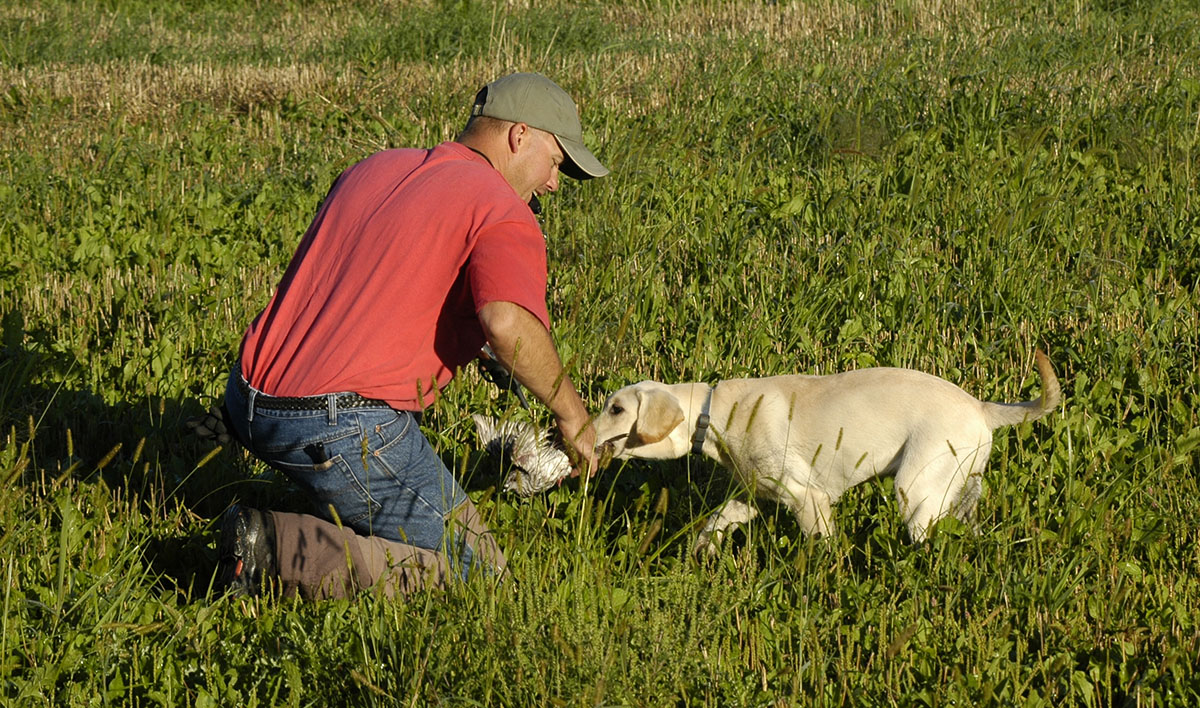
May 28, 2021
Canine Corner: Going live
By Josh Miller
Presented by SportDOG® Brand and originally published in California Waterfowl, Summer 2021.
 A major step in the development of a young retriever is the introduction to real birds. You want to make sure that your dog’s first interaction with feathers is a positive experience because it will help you reach the goal of owning a top-notch waterfowl companion.
A major step in the development of a young retriever is the introduction to real birds. You want to make sure that your dog’s first interaction with feathers is a positive experience because it will help you reach the goal of owning a top-notch waterfowl companion.
I’ve seen too many instances where a retriever owner thought that opening day of duck season was the time to train his dog to pick up real birds. Don’t be that guy. I won’t go into a long list of reasons here about why that’s a horrible idea, but trust me. Instead, I have a much better approach.
YOUNG PUPS
I like to get started on this phase of training when my pups are around 5 to 6 months old. At this point in their young lives, I’ve been working on their obedience training, and they’ll be familiar with retrieving bumpers.
Keep in mind that this 5- or 6-month age is not a hard-and-fast rule. Your dog might be on a different training trajectory than mine or your buddy’s. But, regardless of your pup’s age, what’s most important is that the introduction to feathers takes place in baby steps.
The initial introduction to feathers is as simple as using a pigeon wing during a fun game of fetch in a setting where you are in complete control. That means you need a place with no distractions while your pup is on a check cord so you can reel it back in if it tries to run off with its new prize. Keep the session short and upbeat, and offer lots of praise.
Try to do this early in the morning when it’s cooler. Make sure you have lots of water on hand. We all know California summers can be brutal.
This simple exercise is more important than you might think. It unlocks your pup’s desire to chase and catch something more exciting than canvas or plastic. It ends with the ultimate reward: retrieving and returning to you for praise, which is what it was bred for.
WHOLE BIRD
You don’t need to stay in the wing phase for long. After a couple of sessions, go ahead and move on to using a fresh, dead pigeon. A pigeon is the perfect size for a young dog. It’s easy to pick up and carry, and that’s a confidencebuilder. Use short throws in short grass. This isn’t supposed to be a retrieving challenge. Again, keep your dog on the check cords so you can maintain control.
When working with a pigeon for the first time, be patient. Your pup might not pick the bird up right away. It might sniff it for an unusually long time. It might pick it up and drop it, or even lie down and chew on it. Don’t worry. None of that behavior is disastrous. This is a new experience, so give your dog time to learn. And, as always, use lots of praise and encouragement. Everything your dog experiences around real birds must be positive.
FLAPPING AROUND
Now it’s time to amp up the fun meter. It’s time for a live bird. At this stage, I use a live pigeon. The trick is to create some excitement about the chase without the bird getting away. To do that, simply tape a pigeon’s wing tight to its body. Toss the bird out into some short grass and let your pup chase it down and catch it. The bird will be able to flap and hop around, but it can’t fly away.
If your pup has been making good progress and is already confident around feathers, it shouldn’t be too terribly intimidated by a flapping pigeon. Keep that check cord handy so your dog can’t run off with the bird. And, as if I need to say it again, encourage, praise and reward him. Keep it positive.
You now have a foundation, and you can move on to training with full-size birds such as ducks or pheasants. Don’t feel pressured to rush into that next step. Your pigeon work will have already cemented your dog’s desire for feathers. Next, it’s just a matter of your dog getting used to picking up a larger bird.
While I’ve spent most of this column emphasizing the importance of getting your dog used to real birds, I also recommend that you don’t use them all the time. If your pigeon work has gone well, the next time you train, go back to using bumpers for a few sessions. Then mix in real birds now and then. As much fun as real birds are for your retriever, you don’t want to develop a dog that will only pick up feathers. Its job is to retrieve whatever falls, be it plastic, canvas or the real thing.
As with most everything in retriever training, your patience will be rewarded. If you take the time to properly show your young dog how awesome it is to search for, find and retrieve real birds, you’ll have yourself a diehard feather fiend to be proud of.
Josh Miller is the field specialist for SportDOG® Brand and owner of River Stone Kennels. He has nearly 15 years of dog-training experience and has had numerous successes in AKC/HRC tests and field trials.


